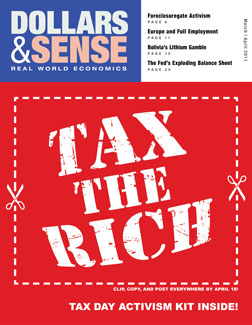This article is from Dollars & Sense: Real World Economics, available at http://www.dollarsandsense.org

This article is from the March/April 2011 issue of Dollars & Sense magazine.
Subscribe Now
at a 30% discount.
Economy in Numbers
State Workers Face a Compensation Penalty
The campaign against state and local workers is often justified with claims that they are privileged relative to their private-sector peers or have somehow been cushioned from the effects of the recent recession and slow recovery. Data from Wisconsin as well as Indiana, New Jersey, and Ohio prove that these claims are clearly false.
In Wisconsin, which has become a focal point in this debate, public servants already take a pretty hefty pay cut just for the opportunity to serve their communities, according to findings by economist Jeffrey Keefe. The figure below shows that when comparing the total compensation (which includes non-wage benefits such as health care and pensions) of workers with similar education, public-sector workers consistently make less than their private-sector peers. Workers with a bachelor’s degree or more—which constitute nearly 60% of the state and local workforce in Wisconsin—are compensated between $20,000 a year less (if they just have a bachelor’s degree) to over $82,000 less (if they have a professional degree).
True apples-to-apples comparisons require controlling for worker characteristics such as education in order to best measure a worker’s potential earnings in a different sector or industry. Controlling for a larger range of earnings predictors—including not just education but also age, experience, gender, race, etc., Wisconsin public-sector workers face an annual compensation penalty of 11%. Adjusting for the slightly fewer hours worked per week on average, these workers still face a compensation penalty of 5% for choosing to work in the public sector.
The story is similar in Indiana, New Jersey, and Ohio. Public-sector workers in all of these states also face an annual compensation penalty—of 7.5%, 4.1%, and 6%, respectively. As in Wisconsin, a higher percentage of public-sector workers than private-sector workers in these states have a four-year college degree, as well as more job experience on average (see table).
The deficit that these states face is caused by the economic downturn and, in Wisconsin, a recent tax-cut package. It has nothing to do with the compensation of the people that educate our children, keep the streets safe and clean, keep dangerous chemicals out of our water, and keep insurance companies from taking advantage of us. These public servants are already paid less than those in the private sector, and nationally, this gap has actually been increasing over the past few decades, according to a report by Keith Bender and John Heywood.
Instead of opportunistically using these hard times to target workers who—because of their public service—already take a substantial pay cut, state politicians should focus on creating jobs and boosting the incomes of all workers.
Did you find this article useful? Please consider supporting our work by donating or subscribing.
